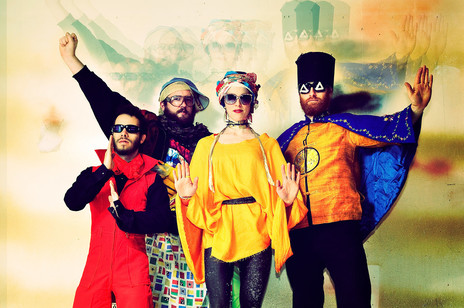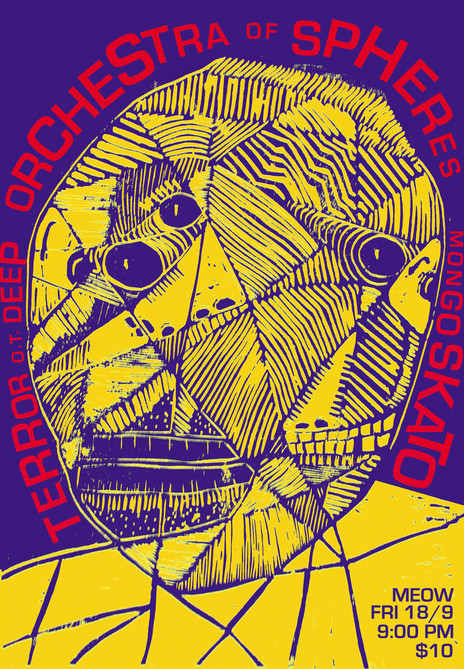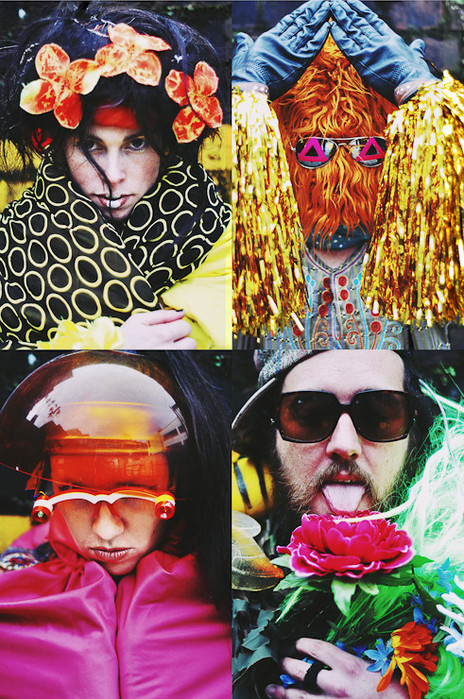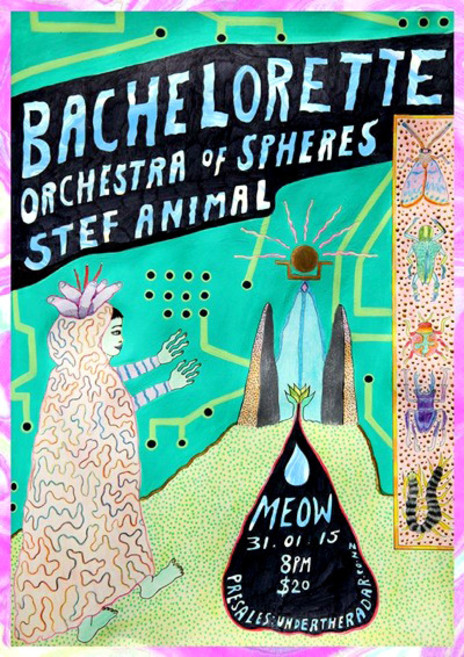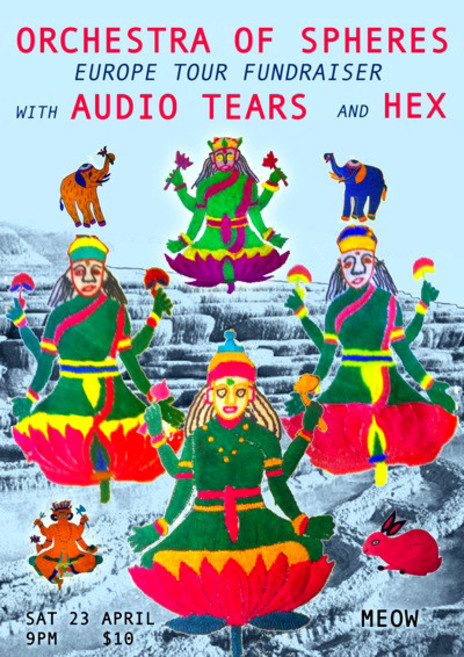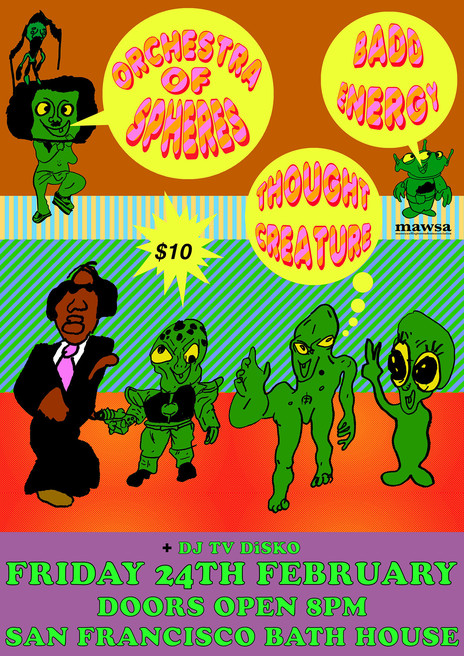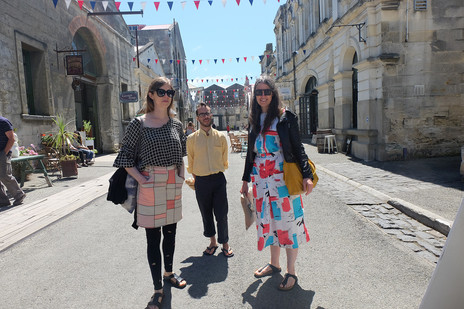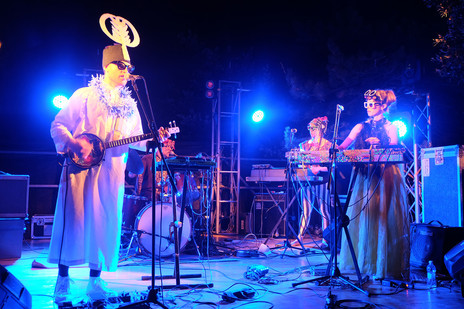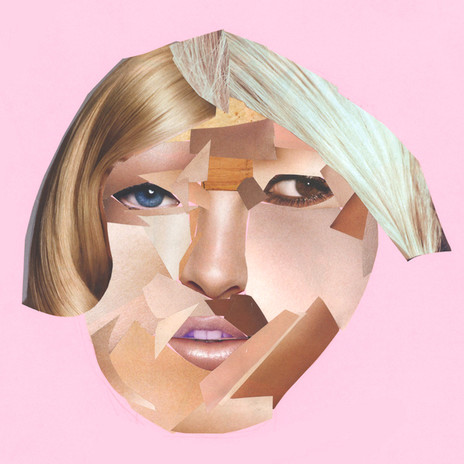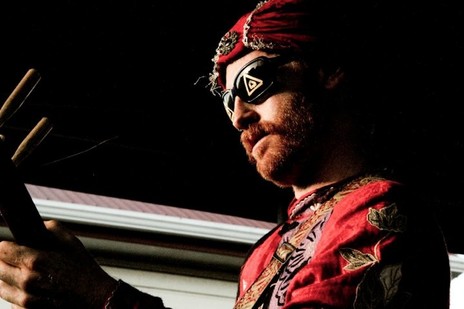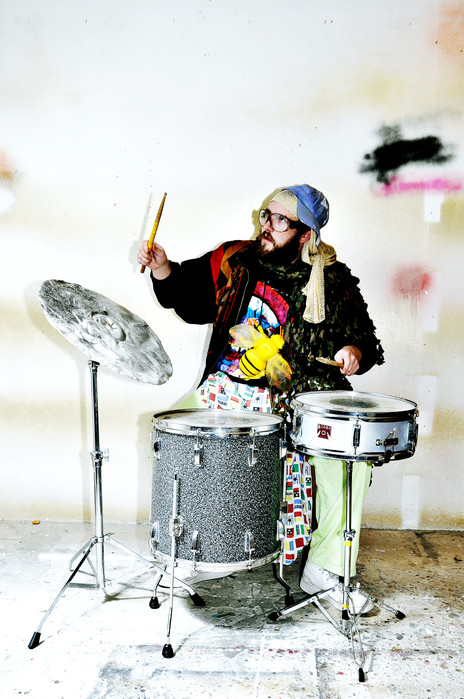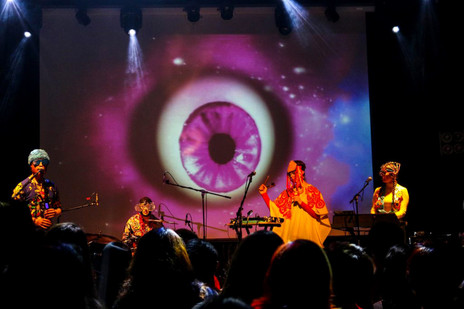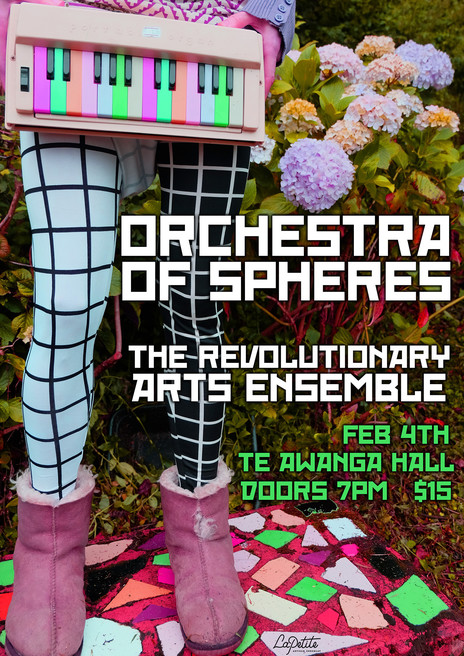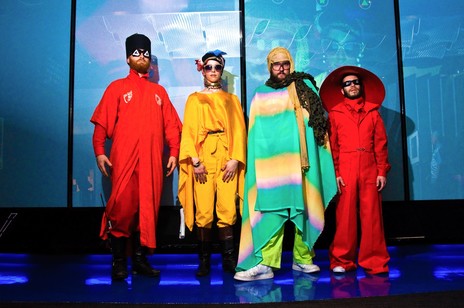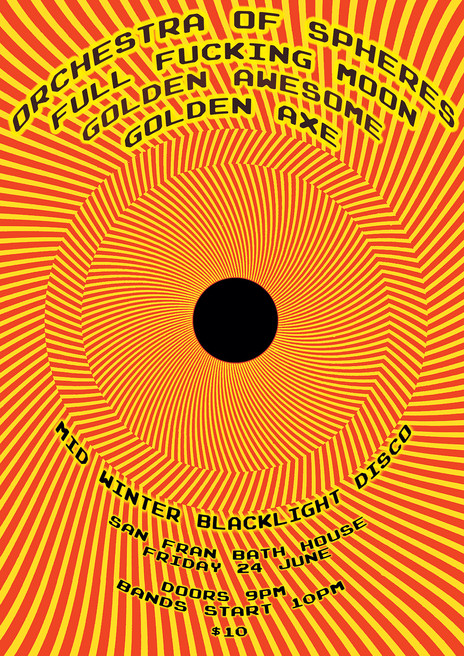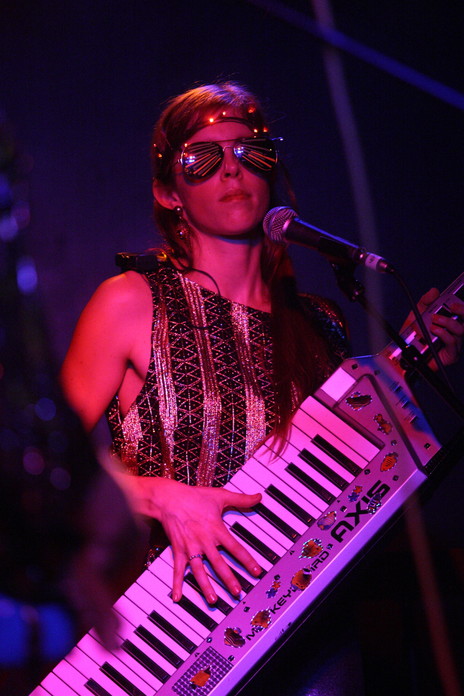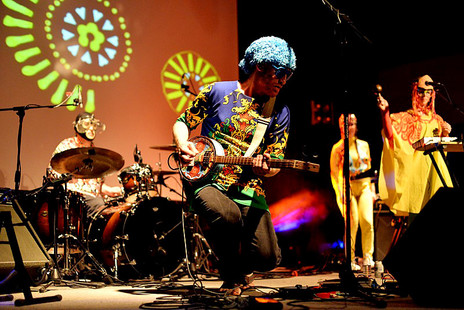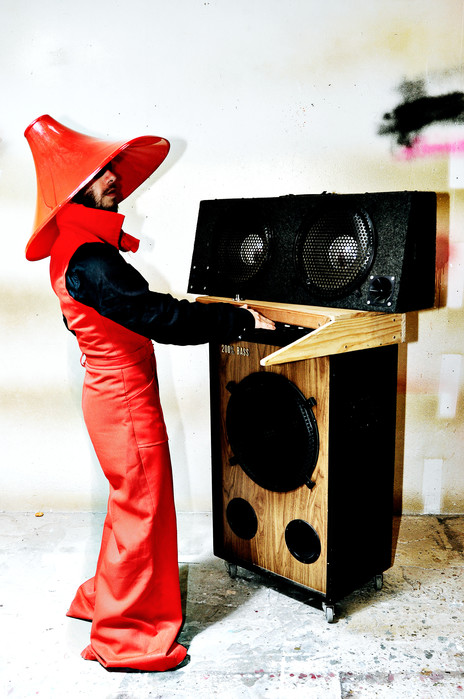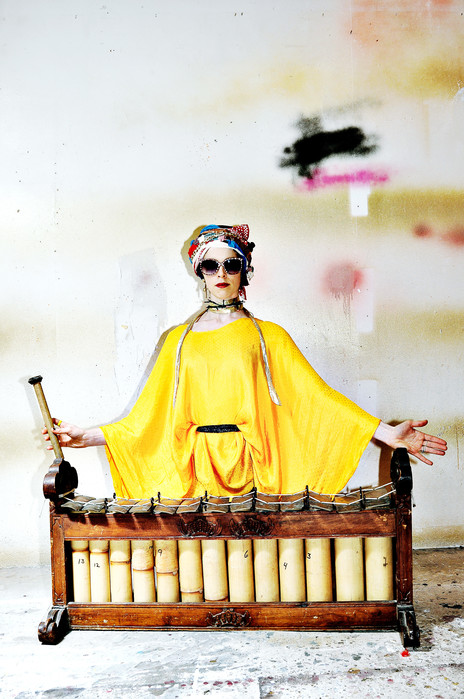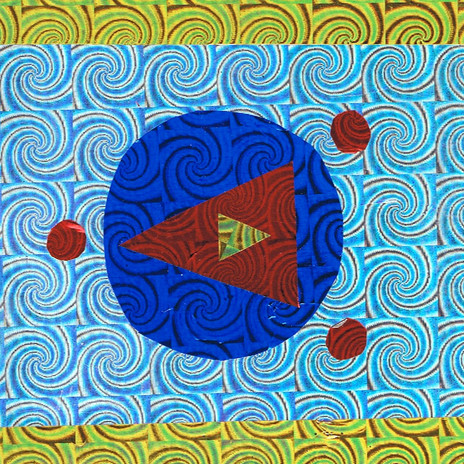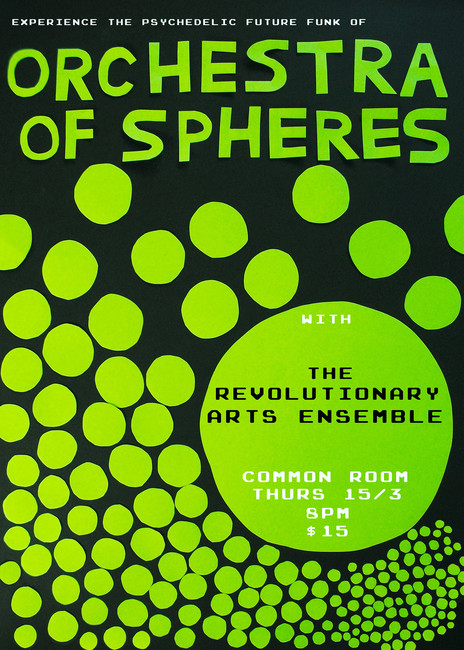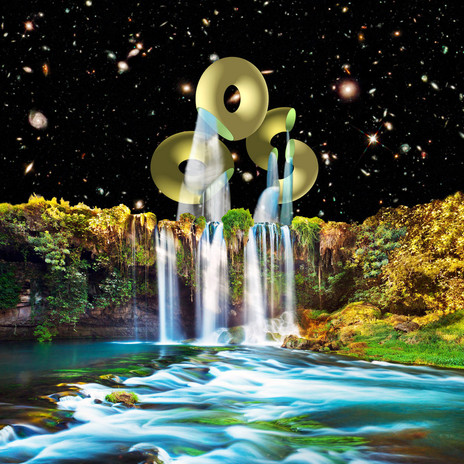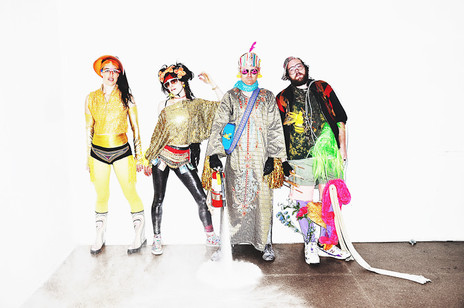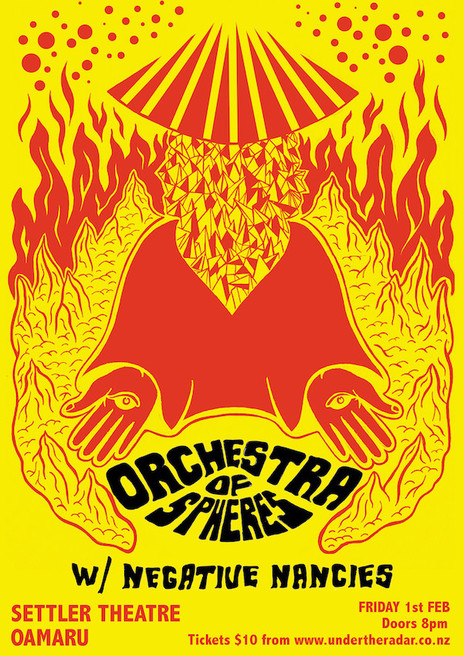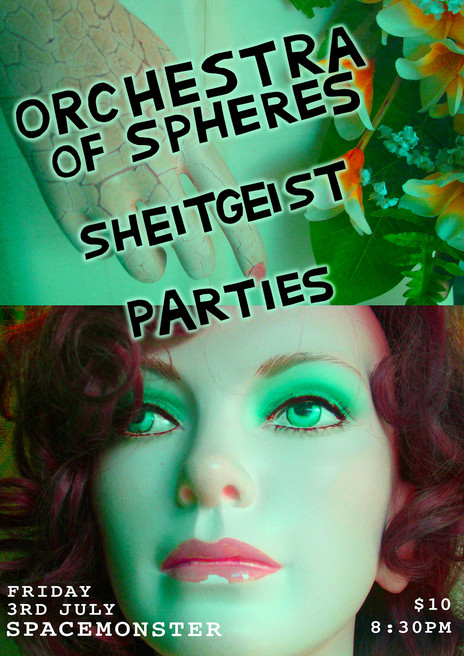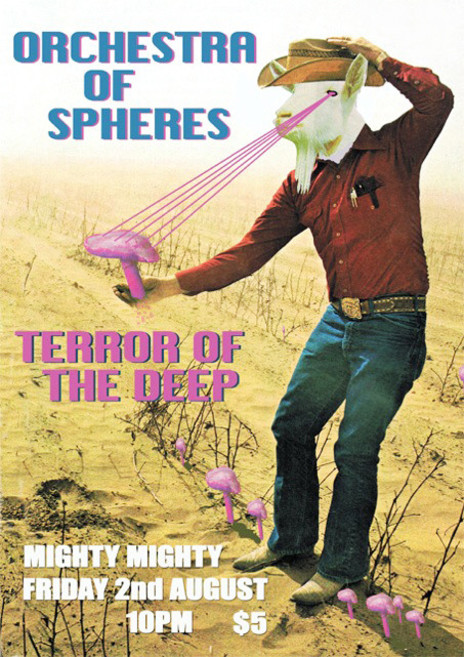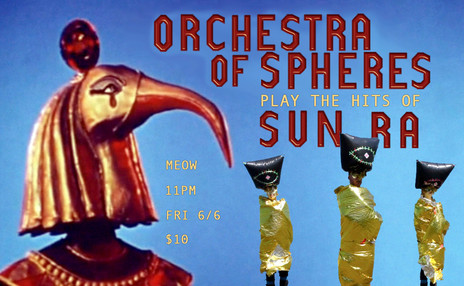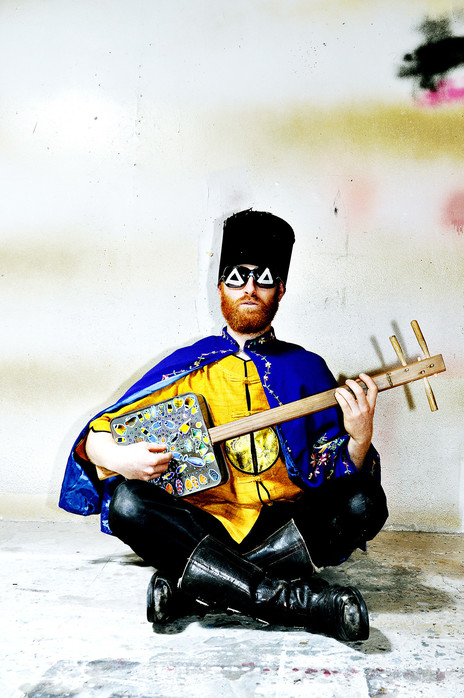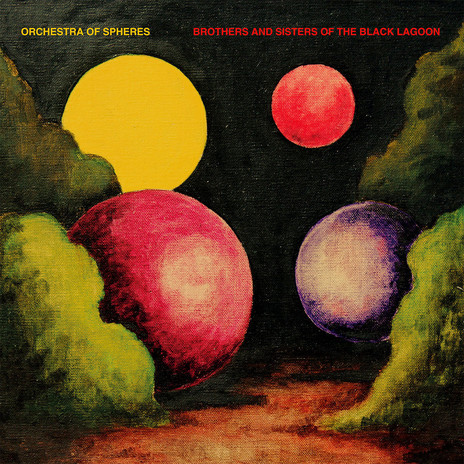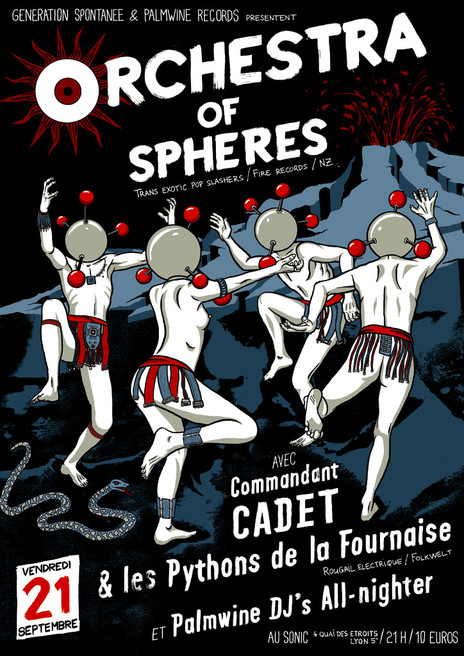Over the last 15 years, Orchestra of Spheres recordings and live performances have taken them around the world multiple times. Along the way, they’ve released five albums and a bunch of EPs, shared stages with The Sun Ra Arkestra, Thundercat, Caribou, and appeared at legendary UK festivals such as All Tomorrow’s Parties.
Freds
In the late 2000s, New Zealand musician, sound artist, and radio sound engineer Daniel Beban returned to Wellington after living in London for five years. During that time, he trained as a studio manager at the BBC World Service before realising it would be easier to pursue his musical interests at home. Inspired by the energy circulating in Wellington’s improvised music communities, Beban led the establishment of the Frederick Street Sound and Light Exploration Society (informally known as Freds) in 2009.
A key local experimental music and arts venue of the era, Freds was housed inside the former Chinese Mission Hall on Frederick Street in Wellington’s Te Aro district. To place it in context, it existed within a lineage of local artist-run spaces including Happy (2003-2009) and The Space (1999-2003), and was the precursor to a similarly minded venue called Pyramid Club, which Beban and his friends have administered in the capital since 2014.
Outside of running Freds and maintaining his own artistic practices, Beban could often be found playing around town with pianist/organist Nigel Patterson (The Black Seeds, Fly My Pretties, The Chandeliers) and drummer/percussionist Anthony Donaldson (Six Volts, Village of the Idiots) in the surf rock/exotica trio The Mantarays. “On a good night at Mighty Mighty, that band would go off,” Beban says. “I enjoyed it because I hadn’t played in bands that did party gigs like that before.” Feeling refreshed by the experience, he started looking at playing for dance floors differently.
At the time, Beban was also thinking about other musical activities he could participate in. After seeing jazz improviser (and now Audio Foundation director) Jeff Henderson play a cigar box guitar, he started building instruments out of found objects. One of them was a homemade biscuit-tin guitar with a contact microphone, which he got to grips with by spending a week jamming with drummer Chris O’Connor, at Freds.
When I interviewed Beban for Rip It Up in 2010, he cited the previous anecdote as Orchestra of Spheres’ origin story. However, in other press interviews, he has instead referenced seeing the Wellington-raised multi-instrumentalist, composer and electronic music producer Jeremy Coubrough (also known as Mandrake or Tlaotlon) playing with experimental musician Ian Downer in the short-lived post-punk duo Bright Colours. “Two stories can be true at the same time,” said Beban, with a laugh.
“Bright Colours was Ian [who is a drummer] playing the guitar with a drumstick, trying to bang the open strings and Jeremy [who wasn’t a drummer] trying to play the drums,” he remembered. Beban told Yadana Saw for RNZ in 2018 that Jeremy “had all these incredible rhythmical ideas and was just figuring out how to do them. He could only play one beat.”
Sensing something unique in Coubrough’s playing, Beban approached him about making music together. After adopting the aliases Baba Rossa (Beban) and Jemi Hemi Mandala (Coubrough), they started improvising at Fred's with bassist and electronic musician Isaac Smith, aka Zye Sosceles. As Beban told BBC Radio 6’s Stuart Maconie for his Freak Zone radio show in 2016, “We’d play these gigs that would go on for two hours sometimes, just trancey grooves.”
Later, Beban’s partner, Nell Thomas, aka Mos Iocoss, joined the group on theremin, gamelan, keytar, and voice. “I think the first gig for the four of us was on 9/9/2009 at Mighty Mighty,” he says. “That seemed like an auspicious date. Suddenly we had all these other sounds and a great singer with a fantastic voice. We were never a band who did traditional songs, but we could do chanted lyrics and repeated lyrics. It all evolved from there.”
Alongside jamming with Coubrough and Thomas, Beban and Smith also sometimes played with the sound engineer and musician Warwick Donald’s Control 6580 group. “That was Warwick’s funny, kind-of-loping band,” Beban says. “One day, there was this revelation: if we took these organ foot pedals and played them with our hands, they’d be a new kind of bass instrument. In my mind, as soon as we did that, that was the start of Orchestra of Spheres.” Actually, scratch his earlier comment about two stories being true at the same time and make it three.
Nonagonic Now
In 2010, Orchestra of Spheres recorded their debut EP Space Art Music and their first full-length album Nonagonic Now, self-releasing them in hand-decorated cardboard CD cases through Beban’s Sound Explorers record label. Alongside these releases, they played shows in Wellington at Freds and other music venues of the era such as Happy and Mighty Mighty. The group’s local buzz swelled to the point where they even shared the stage with TrinityRoots at one of their first reunion shows at the Wellington Opera House.
Given the colourful nature of their music, Orchestra of Spheres would arrive for performances dressed in robes, elaborate headdresses, and eyepieces inspired by American jazz musician Sun Ra and his Afrofuturist sensibilities. Ostensibly, these outfits added to the psychedelic feeling of the group’s fusion of African rhythms, free jazz textures, electronic dance music, krautrock and Indonesian gamelan music. That said, there was also a practical function behind dressing up. “The thing is, man, none of us were particularly comfortable performers,” Beban says. “We were actually quite shy on stage, so we used costumes to work around that.”
From a distance, Orchestra of Spheres’ distinctive fusion of sounds and imagery might look like an eccentric combination. While they’re very much part of an avant-garde set of traditions, from their point of view, it’s more avant-pop. “For all of us involved, Orchestra of Spheres was our version of pop music,” Beban says. “In the past, we’d been far more experimental. That said, it was still all heavily improvised.”
In a review for his Elsewhere website, Auckland music journalist Graham Reid described Orchestra of Spheres and Nonagonic Now as “one part early Talking Heads (or the Feelies as a jazz ensemble), a slug of Sun Ra if he’d come from South East Asia and not Saturn, some seriously brain-bending guitar work (with one ear on mad Afro-juju as much as bent country jiggery and scattergun free playing), theremin, tape machines, chanty sections and lord knows what else.”
Early in 2011, Orchestra of Spheres performed for the second time at Ian Jorgensen/Blink’s Camp A Low Hum festival. There, they were spotted by Canadian electronic musician and DJ Dan Snaith, aka Caribou. He later described the group as “Part Sun Ra otherworldliness, part Sublime Frequencies and part ESG,” invited them to perform at the 2011 edition of the All Tomorrow’s Parties festival in the UK, and released an edit of their song ‘Hypersphere’ under his Daphni alias.
The same week Snaith contacted Orchestra of Spheres, they got another crucial email from Marie-Pierre Bonniol, the founder of Berlin-based Julie Tippex booking agency. Having been referred to Beban by their mutual friend, multimedia artist Torben Tilly, Bonniol was impressed by Orchestra of Spheres’ music and interested in helping to book them in Europe. “Those two people, Dan Snaith and Marie-Pierre, enabled our band to go overseas,” Beban said.
That year, Isaac Smith departed Orchestra of Spheres and headed offshore. He was replaced by Erika Grant, aka EtonalE, on electric bass carillon and additional vocals. After reconfiguring their lineup, they self-released the Numbers CDr EP and – through a connection provided by Bonniol – signed with prestigious British label Fire Records, which re-released Nonagonic Now worldwide in vinyl and CD formats. To support the international re-release, Orchestra of Spheres took part in an extensive tour through Europe and the UK that included appearances at All Tomorrow’s Parties, Les Transmusicales festival in France, a festival in Utrecht, and headline gigs in England, Germany, and the Czech Republic, amongst other locations.
“Our second gig in Europe was at Les Transmusicales in this old hangar playing to five or six thousand people,” Beban remembered. “It was a crazy, amazing, cool experience. We had such a good time that we needed to come back immediately. That was December [2011], and we booked another tour starting in May [2012] that lasted for five months. We were playing in DIY spaces, squat parties and at major festivals. I think we played seventy-five shows. It was amazing and epic, but you go a bit insane after doing that many gigs with the same people in the same van for that length of time.”
Vibration Animal Sex Brain Music
In 2013, Orchestra of Spheres released their second album, Vibration Animal Sex Brain Music, through Sound Explorers in New Zealand and Fire Records worldwide. By this point, the group had settled on calling their music “ancient future funk” and received mixed reviews from UK music press outlets such as The Best of Line Fit and NME. Recorded in Italy in September 2012 onto 24-track tape at Montebelluna’s Outside Inside Studio, Vibration Animal Sex Brain Music caught the group during that 70-plus gig European tour, providing a snapshot of their sound in the heat of the moment.
Alongside the album, they also released an additional double-single 7” titled ‘Fingerweg’ / ‘Lost Days’ through Outside Inside Studio’s in-house label. “Working at Outside Inside was the first time we’d been in a proper recording studio,” Beban explained. “We were recording straight to tape. It couldn’t have been better.”
On reflection, however, Beban realised recording an album under the conditions surrounding them at the time was an “insane idea”. “We’d already done two months of back-to-back shows,” he says. “I was driving a van for up to eight hours. We’d get there, set up, do the show, find the accommodation and maybe not get to sleep until two in the morning. Then we’d be back up at 7.30 am to get on the road. You just get in a super trance, and then we decided to record an album on the week we had off from touring.”
Vibration Animal Sex Brain Music and ‘Fingerweg’ / ‘Lost Days’ were also notable in that they represented the moment when Orchestra of Spheres began accompanying their singles with elaborate, high-concept music videos delivered in the same psychedelic aesthetic as their live performances. Either self-produced or helmed by directors and visual artists such as Simon Ward, Jay Winebrenner, Brydee Rood, Will Sklenars, Georgette Brown and Dan Harris, these surreal clips added substantially to the group’s otherworldly lore.
In 2014, Orchestra of Spheres toured America for the first time and travelled to Iceland to appear at the well-regarded Iceland Airwaves Music Festival. They also played a special one-off tribute show at Meow in Wellington, celebrating the works of the late American jazz composer and bandleader Sun Ra and his Arkestra ensemble. Alongside these efforts, Beban led the establishment that year of a new Wellington experimental music space on Taranaki Street called Pyramid Club.
Much like Freds, which was shuttered in 2012, Pyramid Club was conceived to also provide practice rooms, recording facilities and work spaces for members of the local sonic and visual arts community. A decade later, it remains a creative hub for the local counterculture.
Brothers and Sisters of the Black Lagoon
In 2014, Jeremy Coubrough stepped down from drumming duties in Orchestra of Spheres and relocated to Melbourne and later Berlin, where he continued developing his avant-garde electronica project, Tlaotlon. He was initially replaced by musician, artist, and designer Andy Wright and later by Riki Gooch, who adopted the moniker Woild Boin while he was playing with Orchestra of Spheres.
The next summer, Orchestra of Spheres tracked their third album, Brothers and Sisters of the Black Lagoon, at Pyramid Club, with Gooch handling recording duties. Before the year was out, the group collaborated with director Stephen Bain and multimedia projection artist Erica Sklenars, aka Lady Lazer Light, on a psychedelic children’s musical theatre show at Paramount Theatre as part of the Capital E festival. They also toured China for the first time, taking Sklenars with them for nine shows presented by Chinese New Zealand music promoter Kristen Ng and her Kiwese organisation.
The following year, Fire Records released Brothers and Sisters of the Black Lagoon (2016) worldwide. Eccentric and challenging, it won Orchestra of Spheres acclaim from Vice and The Guardian, who described the album as “playful dance music designed to take your mind off the fact that we’re all doomed.” They were also celebrated by BBC Radio 6 host Stuart Maconie, who interviewed the group on his Freak Zone show while they were touring Europe and the UK for the third time.
In 2017, Orchestra of Spheres self-released a limited-edition cassette collection of tape recordings made between 2009 and 2016 through Sound Explorers under the title Pastel Cat in a Crystal Tube. “That’s my favourite of all our albums,” Beban says. “It’s just me taking our demos and rehearsal recordings and putting them through tape machines to slow them down and speed them up. That’s what this band sounds like, but no one has heard it because it came out on a cassette.”
Mirror
In 2018, Orchestra of Spheres reconnected with Fire Records for the worldwide release of their album Mirror. Recorded in an industrial warehouse studio run by Wellington musician and audio engineer Warwick Donald, Mirror saw the group working with a rich cast of local collaborators, including Lucien Johnson (baritone and soprano saxophones), Blair Latham (bass clarinet), Oscar Lavën (oboe, bassoon), Peter Daly (viola), Jonny Marks (synthesisers) and Reece McNaughten (percussion). “This time around, I wanted us to open up the music,” Beban said. “One thing I like about that record is I feel like it’s also a document of the group of people who played with us on it.”
Nine years into their musical journey, Mirror found Orchestra of Spheres’ homegrown DIY exotica in peak form. On release, it won acclaim from the prestigious British music and pop culture website The Quietus, which described the album as a “new plateau of ingenuity, balance, and coherence” for the group.
Closer to home, in a review for Radio New Zealand’s The Sampler, music critic Nick Bollinger dubbed Orchestra of Spheres “ethnographers of the imagination” while noting the group’s reverence for African musical forms and making comparisons to Talking Heads, Tom Tom Club and The Grateful Dead. “In terms of my lyric writing and songwriting, I felt a lot more comfortable on that record than I had on our previous ones,” Beban said.
After touring Europe again later that year, Orchestra of Spheres returned home, where they continued to mount unique performances across New Zealand and shared stages with visiting luminaries such as the cult American artist and musician Lonnie Holley.
In July 2019, they celebrated their 10th anniversary as a group with a headline concert at Meow in Wellington. Ahead of the gig, Orchestra of Spheres made a heartfelt statement on the event’s Facebook page. They noted the countless hours they’d spent jamming, sweating, gigging, recording, and exploring the world together before sending thanks and love to everyone they’d crossed paths with over the last decade through music. As they concluded, “There’s still much more to come from the collective OoS brain.”
On the night, they invited multimedia artist ENT! to handle lighting and stage design and their friends Terror of the Deep, Kraus, and DJ Oonaverse to play support. “Lo and behold, who should turn up to that gig but Isaac Smith, fresh back from Sri Lanka,” Beban recalls. ‘We didn’t even know he was back in the country, but we had to have him come up on stage with us.”
A New Era
Since the dawn of the 2020s, performances by Orchestra of Spheres have been select and intentional. Some highlights have included playing at Te Papa’s Surrealist Soiree, a Matariki performance at Paraparaumu Beach’s Maclean Park, and appearing inside the Futuna Chapel alongside Roy Montgomery in Wellington.
In recent years, their music has transformed into a new set of shapes and forms. “I think the gig that I’d look at as most likely to be the template for what we might do in the future is when we played with Roy,” Beban explained. “Nell and Erika were playing gongs and crystal bowls, I’ve got a tape machine, and Riki and Isaac were on electronics. It was an hour-long super-ambient set, and it was unlike anything we’ve done before.”
Outside of their group activities, Orchestra of Spheres members have stayed busy. Several times a month, Grant runs gong baths (sound baths) in different community halls around the capital and across the country. Gooch recently completed a Doctor of Musical Arts degree in composition. Smith continues to play music around the country and overseas in various capacities. Thomas has been participating in improvised performances and designing handmade record covers for Pyramid Club’s latest venture, Pyramid Club Records.
Aside from his own music and art projects and operating Pyramid Club, Beban has been working on a history book about avant-garde music in Wellington during the 1980s titled Future Jaw-Clap: The Primitive Art Group and Braille Collective Story. It will be released in November 2024 through Te Herenga Waka University Press.
“The cool thing about Orchestra of Spheres is everyone who has been part of it are really interesting artists who also do their own things,” Beban said. “That’s what I love about it: everyone brings their own thing or point of view. Together, we pull the collective in different ways and stretch each other’s ideas. I’ve always pushed it in some ways, but the whole thing is porous and open. It’s always been about what we want to do as a group.”
--
